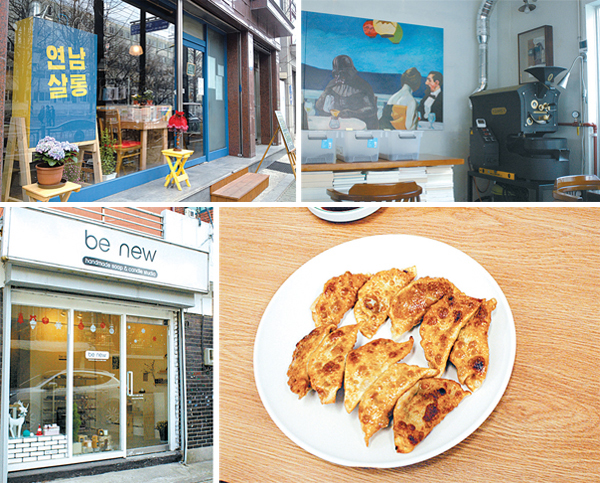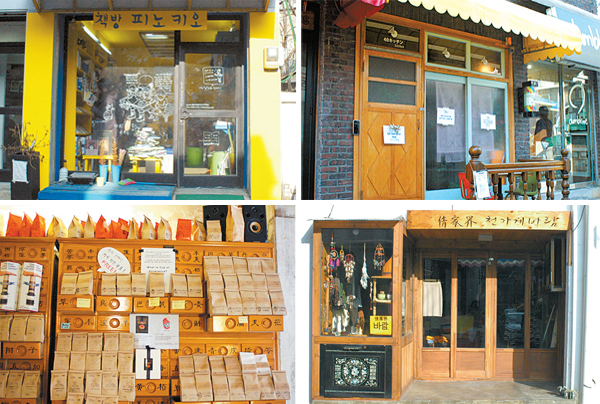Seoul’s latest hot spot: the run-down alleys of Yeonnam-dong

Case in point - take a look at the most popular hangouts around Seoul. Samcheong-dong, to the east of Gyeongbok Palace, is a favorite for many, even if the big-name coffee shops and franchises are beginning to move in. Seochon, to the west of Gyeongbok Palace, is also popular, with its narrow alleys, brick walls and old buildings.
Now Yeonnam-dong, close to Hongik University in western Seoul, has become the latest “it” place.
It only takes a few minutes to walk from Hongik University Station to Yeonnam-dong, but the neighborhood looks like a different planet from the more modern parts of the city. Time stands still in this neighborhood, as many of its markets, drug stores and other shops still use old signboards and fonts from 20 years ago, and narrow, labyrinthine alleys are everywhere.
Yeonnam-dong was originally part of the posher Yeonhui-dong to the north, but they were separated in 1975 - the “nam” in Yeonnam-dong means “south.” It’s long had a large Chinese community here, as well as Hansung Chinese School.
Many of the shops, cafes and restaurants are clustered around two landmarks: Dongjin Market, the nearly empty building on the main road that connects Hongik University Station to Yeonhui-dong, and Donggyo-ro, where a string of restaurants, many open all night, proclaim that they are there for the taxi drivers (anyone can eat there, though).
But throughout Yeonnam-dong, shops are nestled in unlikely locations, which is the biggest charm of this neighborhood - being able to stumble upon small, unusual shops as you walk around.
Another wonderful thing about this old area is its uniqueness. There are few franchises here, and each small shop has its own special way of doing things, even if that’s just how it makes a cup of coffee.
Since each place has its own personality, just looking around is a lot of fun - plus the zany interiors of some of these stores might be able to inspire some decorating ideas for your own home.
With the long and dreary winter finally coming to an end, spring is in the air and it is a great time for walking. If you want to enjoy the new season and explore a new part of town, there is no better place to start than Yeonnam-dong.
To get to Yeonnam-dong, go to Hongik University subway station exit No. 3 and walk north.
Or, if you would like to go by bus, go to the Hongik University subway station, exit No. 2, and take a green Mapo 05 bus for just a couple of minutes.
Here is a list of a few places in Yeonnam-dong that the Korea JoongAng Daily visited.

Clockwise from top left: 1.Yunnam Salon; 2.Wangchang Sanghoe; 4. Ipum Bunsik; 3.Be New
Yunnam Salon used to be famous for all the stray cats that would hang out there - the owner makes a point of feeding the local felines. But it just moved a few weeks ago, and the new spot, on a big road, is not so good for the cats.
Nevertheless, cafe owner Park Sung-eun is a “cat mom,” and she likes to help out the local strays.
“It’s dangerous for them to come here because this cafe is next to a main road,” said Park.
But for 500 won ($0.46), you can buy a little bowl of snacks and feed them to the local cats.
For humans, Yunnam Salon still sells hot chocolate in the winter, lemonade in the summer, and its popular cheese melt toast all year round.
Homemade strawberry jam and apple compote come with any toast order. You can also rent books here, but the slack rental policy means you can return them at any time you want.
The coffee here starts at 3,000 won and the cheese toast is 5,000 won. The cafe also has some alcohol options, with matching dishes like pan-fried sausages.
The cafe opens at noon and closes at 10 p.m. It is closed every Tuesday.
(070) 4038-2991, blog.naver.com/ynsl2011
2.Wangchang Sanghoe
This cafe is located in the middle of a residential area, but its royal blue awning makes it stand out clearly from a distance.
Sanghoe (pronounced “sang-hway”) is an old way of referring to a store, while wangchang is an adverb that means “a lot.”
The store is run by a couple - the wife makes all the desserts and the husband roasts the coffee beans and makes the coffee. The cafe is famous for its macarons and castella (a Portuguese-inspired Japanese sponge cake), but the bakery’s showcase was almost empty when this reporter visited the place because the wife was on maternity leave. Until she returns to the cafe, she has cut back on how many desserts she can make in a day.
The cafe offers a wide array of coffees, but the house blend is chocolaty and rich. A set of Wangchang coffee and a macaron costs 6,000 won. Unlike its name, though, the portions are not wangchang.
The store is open from 11:30 a.m. to 10 p.m. each day. It is closed every Sunday. (02) 732-5210
3.Be New
This small but romantic store, dedicated to all kinds of organic and natural soaps, stands in the midst of some ordinary houses.
According to the store, it takes six weeks to make a single bar of soap.
Of the many soaps here, some are mild enough for babies and some are made with powdered pearl. The latest trend among young mothers these days is making soap out of their own breast milk.
The best-selling products here are the macaron-shaped soaps that come in all pastel hues. There is also a daylong class available to teach you how to make the macaron soaps.
It’s pricey, though, as a single soap starts from 13,000 won.
Opens from 11 a.m. to 8 p.m. Closed every Tuesday.
(02) 6497-7775, www.benew.co.kr
4. Ipum Bunsik
Ipum Bunsik is a small restaurant with only five tables and a simple menu - only three kinds of dumplings.
Clearly, this is not a fancy restaurant. The dumplings are served on plastic plates, with rolls of toilet paper on each table for napkins. But its hearty servings and affordable prices are commendable.
One serving of pan-fried dumplings costs just 5,000 won ($4.70) for 10 pieces. Crispy on the outside and soft on the inside, the dumplings are crunchy enough to make the inside of your mouth raw.
But its main offerings are the king-size dumplings, stuffed with pork and mushrooms, for 5,000 won.
The food is made by a Chinese-Korean grandfather in his mid-80s, with his cute wife working as his assistant.
“We used to run a Chinese restaurant for many years in Yeonhui-dong and retired a few years ago, but he wanted to do something for fun, so we opened this place some months ago,” said the grandmother.
Ipum (pronounced “ee-poom”) means “authentic” or “original,” while bunsik refers to flour-based snacks. It opens each day at 10 a.m. and closes at 9 p.m. The store is closed the first and third Monday of each month. (02) 333-3130

Clockwise from top left: 5. Pinokio Bookstore; 6. 40 Kitchen; 8. Cheongagye Baram; 7. CafE Libre
When was the last time you read a picture book? If you can’t remember, visit the canary yellow bookstore Pinokio Bookshop, where you can revisit your past just by flipping through picture books.
Opened in June 2012, the bookstore specializes in illustrated books.
The tiny bookstore can accommodate only five or six people at a time, but Lee Hee-song, the owner, doesn’t even glance at visitors. You are allowed to read as long as you want.
When the temperatures go up, the bookstore puts a wooden bench out in front so that anyone can rest there, even though they are not visiting the bookshop.
Prices start from 10,000 won, and there are also postcards and some stationery available in one corner.
The store is open from 1 p.m. to 9 p.m. each day. It is closed every Monday. (070) 4025-9186, blog.naver.com/pinokiobooks
6. 40 Kitchen
Visiting 40 Kitchen might make you think that you are in a small town in Japan. The small yet stylish vintage restaurant, which can barely accommodate 15 people, is run by a sister and brother who studied in Japan.
Of the many Japanese dishes here, the most popular is the cabbage roll, inspired by the Japanese film “Honokaa Boy” (2009) - ground pork is wrapped in cabbages and covered with cream sauce. It tastes like a dumpling but the cabbage lessens the greasy taste of pork. Two big dumplings cost 11,000 won.
Other than the food, the restaurant is full of knickknacks, making it look like the cozy home of someone’s grandmother.
Unfortunately, the restaurant is tremendously popular, so people are always lining up, forcing those inside to eat quickly.
Lunch is available between 12:30 p.m. and 2:30 p.m., while dinner is served between 5:30 p.m. and 11 p.m. It is closed every Tuesday.
(02) 324-4040
7. CafE Libre
If you think that sour is one of the most important things that makes a decent cup of coffee, you must visit Cafe Libre.
Cafe Libre is already famous after its coffee was chosen as the top in the land by the TV show “Producer Lee’s Food X-file,” which sends undercover food experts all over Korea to search for the best food in the country. Cafe Libre roasts its own beans, and the owners travel the world to find the best beans. It only offers four basic options - espresso, latte, cappuccino and Americano, each with a 4,000 won price tag.
If you are a fan of coffee topped with a thick layer of whipped cream, Cafe Libre is not for you. But if you like strong, distinctive brews, visit Cafe Libre and smell the coffee.
It is open from noon to 9 p.m. The store is closed every Monday.
(02) 325-7140, www.coffeelibre.kr
8. Cheongagye Baram
When you step into Cheongagye Baram, which roughly translates to “Fabric Store Wind,” you are hit by fragrances that call to mind Thailand, Indonesia or India. As the name suggests, the small store is packed with exotic odds and ends, like dream catchers, incense sticks, exotic fabrics and Indian perfumes, all purchased by the owner of the store during his travels around the world. The owner also runs a curry restaurant next to the fabric store.
A medium-size, well-made dream catcher costs 12,000 won and a box of incense from India is 3,000 won. This is an ideal place when you feel like buying something unique for your friends or loved ones.
The store is open from 2 p.m. to 9 p.m. It is closed every Wednesday.
(010) 4743-1055

9. Place Mak
In addition to the cafes and restaurants, Yeonnam-dong also has some art galleries, and Place Mak is one of the most interesting ones. As its name suggests - mak means “layer” or “curtain” in Korean - one needs to draw aside a curtain to enter Place Mak.
Place Mak opened in 2010 with the aim of sharing art with anyone who is interested but doesn’t have the time to visit Seoul’s distant art galleries.
The current exhibition is titled “Welcome! Space Brothers,” featuring an art installation by Hong Jang-oh.
It is open from noon to 8 p.m. every day, except for Mondays.
(017) 219-8185, www.placemak.com
BY SUNG SO-YOUNG [so@joongang.co.kr]










with the Korea JoongAng Daily
To write comments, please log in to one of the accounts.
Standards Board Policy (0/250자)